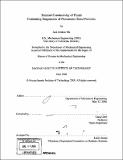| dc.contributor.advisor | Gang Chen. | en_US |
| dc.contributor.author | Ma, Jack Jeinhao | en_US |
| dc.contributor.other | Massachusetts Institute of Technology. Dept. of Mechanical Engineering. | en_US |
| dc.date.accessioned | 2007-02-21T13:14:23Z | |
| dc.date.available | 2007-02-21T13:14:23Z | |
| dc.date.copyright | 2006 | en_US |
| dc.date.issued | 2006 | en_US |
| dc.identifier.uri | http://hdl.handle.net/1721.1/36248 | |
| dc.description | Thesis (S.M.)--Massachusetts Institute of Technology, Dept. of Mechanical Engineering, 2006. | en_US |
| dc.description | Includes bibliographical references (leaves 59-62). | en_US |
| dc.description.abstract | Nanofluids, which are fluids containing suspension of nanometer-sized particles, have been reported to possess substantially higher thermal conductivity than their respective base fluids. This thesis reports on an experimental study of the effect of base fluid, particle size, particle volume concentration, and sonicating technique on the thermal conductivity enhancement of nanofluids. Thermal conductivity measurements for several combinations of nanocrystalline materials and base fluids were conducted with the transient hotwire technique. Results show that the thermal conductivity enhancement of nanofluids increases with particle volume concentration, with higher thermal conductivity enhancement observed for ethylene glycol than deionized water base fluids. However, most of the enhancement observed can be explained based on classical Maxwell-Garnett effective medium theory. Although ethylene glycol containing gold nanoparticles produces significantly higher enhancement in thermal conductivity over those predicted by the Maxwell-Garnett theory, Fourier transform analysis indicates that the anomalous enhancement in thermal conductivity observed with the gold-ethylene glycol nanofluids is due to the presence of water. | en_US |
| dc.description.abstract | (cont.) Furthermore, results show that higher enhancement in thermal conductivity can be obtained by sonicating the aluminum oxide-deionized water nanofluids with a more powerful sonicating tool prior to thermal conductivity measurement. This leaves room for future exploration in the effect of particle size and distribution on heat transfer in nanofluids. | en_US |
| dc.description.statementofresponsibility | by Jack Jeinhao Ma. | en_US |
| dc.format.extent | 62 leaves | en_US |
| dc.language.iso | eng | en_US |
| dc.publisher | Massachusetts Institute of Technology | en_US |
| dc.rights | M.I.T. theses are protected by copyright. They may be viewed from this source for any purpose, but reproduction or distribution in any format is prohibited without written permission. See provided URL for inquiries about permission. | en_US |
| dc.rights.uri | http://dspace.mit.edu/handle/1721.1/7582 | |
| dc.subject | Mechanical Engineering. | en_US |
| dc.title | Thermal conductivity of fluids containing suspension of nanometer-sized particles | en_US |
| dc.type | Thesis | en_US |
| dc.description.degree | S.M. | en_US |
| dc.contributor.department | Massachusetts Institute of Technology. Department of Mechanical Engineering | |
| dc.identifier.oclc | 77275395 | en_US |
